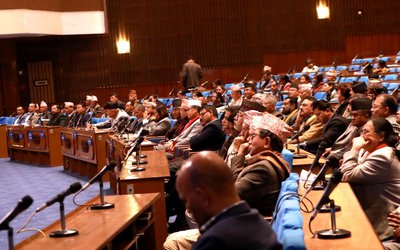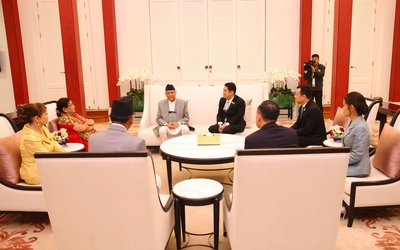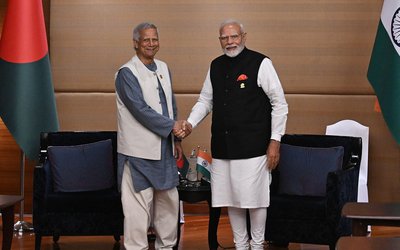More on News





China an emerging global major power and potential rival of the USA, has influential presence in South Asia, which is a cause of big worry for another emerging South Asian regional power, India. Due to its misguided regional policies, India is almost losing its presence in the region and the south Asian states are fast tilting towards China.
China is good bet for them because of its economic robustness. It has overtaken Japan in 2010 to become second largest economy of the world.
Both India and China started their post-independent development innings together and they were at par, in terms of economic growth and development, for almost two decades after their independence. China joined the eastern block, early but later on when differences surfaced between the former USSR and China and near-to-war situation developed between the two over claims on Uri River in late 1960s, it switched its loyalty towards the US-led western block. Under the leadership of liberal reformist Deng Xiao Peng it completely reversed its economic policies, which has been continued by Deng’s successors, resulting in its transformation from closed, self-satisfied economy under Mao, to one of the main proponents of liberal capitalism. India, on the other hand, maintained a socialist economic order after its independence and continued it till 1991. Politically, it kept itself aloof from the cold war block politics and successfully launched the NAM, with other like minded developing countries. As a democratic country India has gained global status and makes everyone proud to the fact that it has successfully managed the democratic system for more than six decades. But the dreams and promises, which were supposed to get fulfilled through it, have been only partially fulfilled. Despite a constitutionally guaranteed political, economic and civil rights, India failed to resolve its internal problems and relied more on coercive means to maintain its sovereign stature. As a result the problems in Kashmir, Northeast and Naxalism are still persisting. On the other hand China, from the beginning, has been under the dictatorial rule of the Communist Party. Sometimes the authorities have turned brutally against its citizens: the protestors were marauded at Tiananmen in 1989 and also People's Liberation Army (PLA) was given free excess to deal with the dissidents in Xinxiang. The federal government has also adopted development model to silence the voices of dissent by developing infrastructure and providing employment to the youths.
After silencing the internal dissidents, China has successfully dictated all its prolonged border problems with its immediate neighbours. The exceptions are Japan and India with whom it still has disputes over the border territories. With the growing economic robustness and global political clout, China has become much more assertive towards these two countries, especially towards India, to which it consider main rival and hurdle in its ambition to become major global power. To contain India, China has created “pearl of strings” in Indian Ocean to militarily encircle it. It is also interfering politically and economically in South Asian affairs, though steadily, in order to establish its hegemony in this region at cost of India.
The political and economic space, which China is trying to occupy in South Asia, is mainly due to India’s negligence of its small but strategically important neighbours. India’s misadventures in the region has led to widespread trust-deficit against it. Sometimes, it has unnecessarily interfered in affairs of its neighbouring countries. In Sri Lanka it supported the LTTE against the Sinhala dominated Sri Lankan state but later on sent its army to fight against the LTTE. After the assassination of the former Prime Minister, Rajiv Gandhi, LTTE was declared a banned organisation. Thus it lost the support from both Sinhalas as well as from the Indian Tamils in Sri Lanka. In Bangladesh it enjoyed support during the era of Sheikh Mujib but after his assassination it does not. Anti-India constituency is growing very fast there. In Nepal India’s position has been switched from supporting the monarchy and Nepali Congress leadership. After decline of monarchy, Maoist led popular government came into power. However India successfully managed to destabilise that government. Now after decline of Madhav Nepal’s government, India is trying best to get ‘its man’ appointed as Prime Minister of Nepal. This type of attitude has made the people from these countries suspicious towards India.
Recently, China has adopted aggressive policies towards Jammu & Kashmir and Arunachal Pradesh which is an open challenge to the India’s territorial integrity and sovereignty. The presence of 7000 to 11,000 soldiers from PLA in Gilgit-Baltistan, as mentioned by Selig Harrison in New York Times on 26 August 2010, is a challenge to India’s official position on ‘disputed’ Pakistan side of Kashmir. Earlier in 1963 Pakistan ceded a part of its administered Kashmir to China in order to improve its relationship with it and also complicate the Kashmir problem by including China as a party to any future negotiation for conclusive resolution of this issue. Lately, China on its eastern border with India has deployed nuclear capable missiles. China is impatient power and is frustrated given the placement of US in Asia. The US had conducted a successful military exercise with Vietnam, an opponent of China in Southeast Asia and is constantly improving its relationship with India. As a feeble power Vietnam does not have much to challenge the Chinese interests so it is bit relaxed. But India can pose a greater challenge to the Chinese ambition; therefore it aggressive in its policies towards India.
Deteriorating relationship between India and China are going to have global, continental and regional repercussions. Although, the dialogue between the two is an option but due to proved historical record of China’s betrayal it is not possible to rely on. So, the only option India has is to increase its power both hard and soft to challenge China’s presence in its backyard. Besides, it has to sort out all ongoing internal problems by making some compromises with the internal actors. The cohesive society is must for meeting any future challenges from China.
Author is Ph D scholar in South Asian Studies, School of International Studies,Jawaharlal Nehru University and can mailed at amitranjan.jnu@gmail.com.







